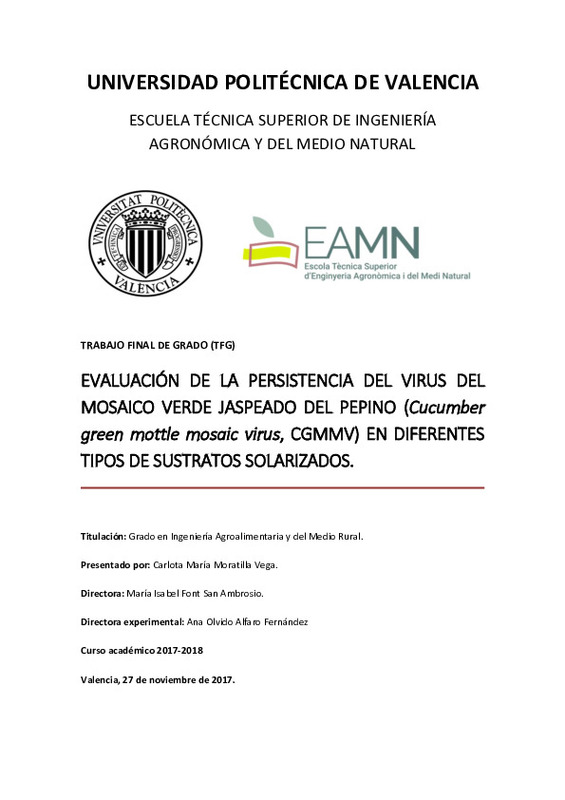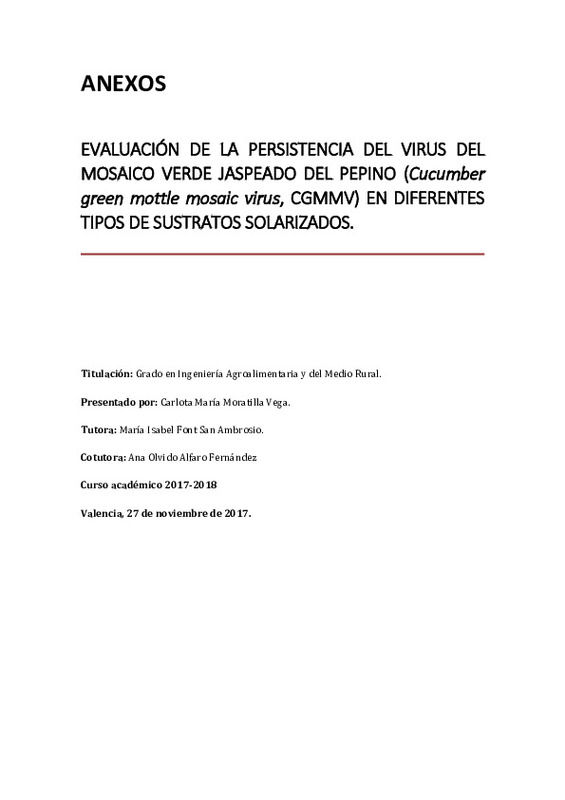JavaScript is disabled for your browser. Some features of this site may not work without it.
Buscar en RiuNet
Listar
Mi cuenta
Estadísticas
Ayuda RiuNet
Admin. UPV
Evaluación de la persistencia del Virus del mosaico verde jaspeado del pepino(Cucumber green motle mosaic virus, CGMMV) en diferentes tipos de sustratos solarizados
Mostrar el registro sencillo del ítem
Ficheros en el ítem
| dc.contributor.advisor | Font San Ambrosio, Maria Isabel
|
es_ES |
| dc.contributor.advisor | Alfaro Fernández, Ana Olvido
|
es_ES |
| dc.contributor.author | Moratilla Vega, Carlota María
|
es_ES |
| dc.date.accessioned | 2018-01-11T16:16:30Z | |
| dc.date.available | 2018-01-11T16:16:30Z | |
| dc.date.created | 2017-12-22 | |
| dc.date.issued | 2018-01-11 | es_ES |
| dc.identifier.uri | http://hdl.handle.net/10251/94548 | |
| dc.description.abstract | [EN] Cucumber Green Mottle Mosaic Virus (CGMMV) belongs to the genus Tobamovirus and affects cucurbits, especially cucumber. CGMMV is a very stable virus, with a high infectious capacity and that can remain on soil in plant debris during more than 10 months. The typical symptoms of the CGMMV in the cucumber are a decrease in the brightness of the green colour, and an irregular distribution of the pigments in the fruit and the leaf, giving a light green speckled that reduces the fruit quality. This virus was first detected in Spain in 1996 in a greenhouse with cucumber crops. Since then, it has reappeared periodically in cucumber crops, as well as in watermelon and melon. Due to the subsequently CGMMV infection in cucumber crops in the greenhouses of Granada, the aim of this project was to evaluate the persistence of CGMMV after the solarization with or without humidification of two substrates: soil and perlite sacks. These treatments were performed in order to allow improve the self-life of the substrates, allowing their reuse, without compromising the health of the crop. After solarization, the root debris of the previous crop that remain in the perlite substrate were analysed through RT-PCR using specific primers of CGMMV to confirm the presence of the virus. Later, to test the infectivity of CGMMV in plant debris after solarization, seeds of cucumber var. Quarto, previously heat-treated at 70º C for 3 days, were sown in the substrates. After three months of the sowing, the plants were evaluated using DAS-ELISA and RT-PCR specifics to CGMMV. None of the analyzed treatments was effective to neutralize the viral particle present in the tested substrates. However, more studies are needed because the plants grown in the same treated substrates maintained in Granada greenhouses were symptomless during the present growing season. | es_ES |
| dc.description.abstract | [ES] El virus del mosaico verde jaspeado del pepino (Cucumber green mottle mosaic virus, CGMMV) pertenece al género Tobamovirus y afecta diferentes especies de cucurbitáceas, en especial al pepino. CGMMV es un virus muy estable, con una alta capacidad infectiva y que puede mantenerse infectivo en el suelo en los restos de cosecha infectada durante más de 10 meses. Los síntomas típicos de CGMMV en pepino son una menor intensidad del color verde y una distribución variable de los pigmentos en el fruto y hoja, dando lugar a un moteado verde claro que deprecia la calidad del fruto. Este virus fue detectado en España en 1996 en cultivos de pepino en invernadero. Desde entonces, ha reaparecido periódicamente en cultivos de pepino, así como en sandía y melón. Debido a una creciente problemática de infección con CGMMV en cultivos de pepino en invernaderos de Granada, el objetivo de este trabajo fue evaluar la persistencia del CGMMV tras la solarización con humectación o no de dos sustratos: suelo y sacos de perlita; permitiendo su reutilización durante varias campañas sin comprometer la sanidad del cultivo y mejorando, por tanto, la rentabilidad de la explotación. Tras la solarización, se analizaron mediante RT-PCR con cebadores específicos de CGMMV raíces del cultivo anterior que quedaban en los sacos de perlita para confirmar la presencia del virus. Posteriormente, para comprobar la capacidad infectiva de CGMMV en los restos vegetales después de la solarización se sembraron en cada sustrato semillas de pepino var. Quarto, previamente termotratadas a 70ºC durante 3 días. Trascurridos 3 meses de la siembra se procedió a analizar las plantas desarrolladas mediante DAS-ELISA y RT-PCR específicas a CGMMV. Ninguno de los tratamientos ensayados fue efectivo para inactivar la partícula viral presente en los sustratos evaluados. Sin embargo, deben realizarse más estudios, ya que los sustratos tratados con solarización con humedad que quedaron en las parcelas afectadas en Granada no han manifestado síntomas durante la presente campaña. | es_ES |
| dc.format.extent | 43 | es_ES |
| dc.language | Español | es_ES |
| dc.publisher | Universitat Politècnica de València | es_ES |
| dc.rights | Reconocimiento - No comercial (by-nc) | es_ES |
| dc.subject | Cucumber | es_ES |
| dc.subject | Virus | es_ES |
| dc.subject | Solarization | es_ES |
| dc.subject | Transmission | es_ES |
| dc.subject | Subsrate | es_ES |
| dc.subject | Pepino | es_ES |
| dc.subject | Solarización | es_ES |
| dc.subject | Transmisión | es_ES |
| dc.subject | Sustrato | es_ES |
| dc.subject.classification | PRODUCCION VEGETAL | es_ES |
| dc.subject.other | Grado en Ingeniería Agroalimentaria y del Medio Rural-Grau en Enginyeria Agroalimentària i del Medi Rural | es_ES |
| dc.title | Evaluación de la persistencia del Virus del mosaico verde jaspeado del pepino(Cucumber green motle mosaic virus, CGMMV) en diferentes tipos de sustratos solarizados | es_ES |
| dc.type | Proyecto/Trabajo fin de carrera/grado | es_ES |
| dc.rights.accessRights | Abierto | es_ES |
| dc.contributor.affiliation | Universitat Politècnica de València. Departamento de Ecosistemas Agroforestales - Departament d'Ecosistemes Agroforestals | es_ES |
| dc.contributor.affiliation | Universitat Politècnica de València. Escuela Técnica Superior de Ingeniería Agronómica y del Medio Natural - Escola Tècnica Superior d'Enginyeria Agronòmica i del Medi Natural | es_ES |
| dc.description.bibliographicCitation | Moratilla Vega, CM. (2017). Evaluación de la persistencia del Virus del mosaico verde jaspeado del pepino(Cucumber green motle mosaic virus, CGMMV) en diferentes tipos de sustratos solarizados. http://hdl.handle.net/10251/94548 | es_ES |
| dc.description.accrualMethod | TFGM | es_ES |
| dc.relation.pasarela | TFGM\66576 | es_ES |
Este ítem aparece en la(s) siguiente(s) colección(ones)
-
ETSIAMN - Trabajos académicos [3541]
Escuela Técnica Superior de Ingeniería Agronómica y del Medio Natural







